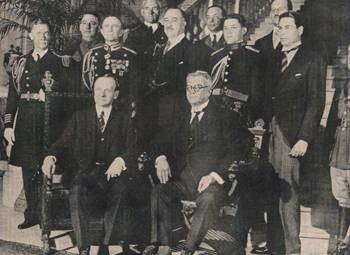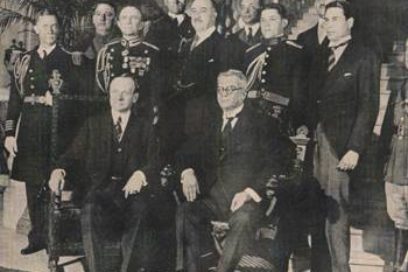 In 1928, the president of the United States of America (US) in power visited Cuba and it has been the only time, which could be a curiosity, but it also leads us to analyze such special occasion that made that head of State come to this island, when the VI Pan-American Conference was held in Havana, Cuba.
In 1928, the president of the United States of America (US) in power visited Cuba and it has been the only time, which could be a curiosity, but it also leads us to analyze such special occasion that made that head of State come to this island, when the VI Pan-American Conference was held in Havana, Cuba.
The Pan-American systemized its conferences after the fist held in Washington between October 12, 1889 and April 1890. From the second conference developed in Mexico (October 22, 1901 to January 22, 1902), these meetings were adjusted every four years, with the third in Rio de Janeiro (July 21 to August 26, 1906) and Buenos Aires (July 12 to August 30, 1910), but there was a period when these meetings were not held due to World War I.
In 1923 they restarted with the V Conference in Santiago de Chile (March 25 to May 3), followed by the one carried out in 1928, in Havana. During all these conferences they tried to stabilize the Pan American system under the leadership of the Americans, with the mechanisms that should make them work, beginning with its office whose venue was based in Washington.
The V Conference have created several uncomfortable situations for the US, due to the evidence of contradictions between the “two nationalities” of America, as it was once classified by Marti. Its predominant role was in dispute by some of the delegations, what drove to the proposal from Uruguay to found the League of the American Nations, conceived as counterpart to the Pan American Union. It considered equal rights and the no conquest by a country to possess other, a matter that the US managed to postpone. This was the immediate precedent. On the other hand, the context of the VI Pan American Conference was kind of complex at a continental level.
In Nicaragua, Augusto Cesar Sandino was fighting against the American military presence in his country, so the “General of Free Men” denounced in a cablegram to the Conference, the role of the US that was sending troops to murder Nicaraguans and made a call to the brother countries to demand the withdraw of that staff.
It was the exhausted moment of the big-stick and dollar diplomacy, with a symbol, the Marine, the landings, invasions, customs’ controls, forced debts and the spreading of US power mainly in Central America and the Caribbean.
With this continental situation there were held the preparations of the event in Havana. In the epoch’s debate we should also remember it had been published by then, the Seven essays with the interpretation of the Peruvian reality (1928) by Jose Carlos Mariategui, where he characterized the main aspects of the Latin American reality, not only the Peruvian one, where there was the Us power policy. Meanwhile in Cuba, Julio Antonio Mella had written in 1925 his work “Cuba: a people that had never been free,” where he analyzed that “the Yankee domination in America” was not like the ancient formulas they put as example during the Roman Empire, or later in the English one, but now “it is of absolute economic power with political guarantees when necessary.” So he asserted: “In all America it is the same. Any government cannot stand up without the will of the US (…). The Dollar defeats the Citizen; we need the Citizen win the Dollar. (…) Indeed, we have to undergo the Social Revolution of the America.” [1]
By 1928 in Cuba, the government was carrying out the constitutional reform that will prolong the period in power of Gerardo Machad,o who highlighted for his hard repression to the popular movements and all kinds of opposition.
Machado had visited the US the year before, as he had declared, to invite President Coolidge to the opening of the Pan American Conference, but he had really made a very profitable tour, for his purposes to continue in power, because he met with different sectors of the great American capital and he found support in them. In such extent that Thomas A. Lamont, Morgan House manager said: I was told that the only matter debated nowadays by the electors in Cuba is to guarantee the continuity of your services, prolonging your period in power by a constitutional reform (…) we want to express you, we do not care about the way you do it, but we will see with pleasure how a so good administrator continues in power. [2]
The event in Havana should be held between January 16 to February 20, 1928, while the government was preparing the elections for delegates to the Constituent Assembly that should pass the reform proposed by the Congress.
The elections should be on March 5 and the beginning of the Assembly on April 19, so the agenda was a guarantee for Machado and his team’s purpose.
The preparation of the VI Conference by the Cuban part was very careful. The government did not invite any entities or nations that were not Americans following Washington’s demands, so it refused the petition of the Nations League Secretary the invitation he requested and did the same with the chargé d’affaires from Spain in Havana which was appropriately informed to the US representation in Cuba.
There was also a strong repression against the labor, students and communist movements so there will be neither protests nor other riots during that event. In fact, the University of Havana, where some of the sessions will be held and they built a beautiful staircase, had suspended classes.
The main problem to debate in the VI Conference will be, undoubtedly, that of the intervention in the internal affairs of the states, which will be very thorny.
The opening was at the national Theater and the great guest was President Calvin Coolidge, who in his speech highlighted Cuba and its government and reminded the colonial past of the island to assert that in that moment Cuba was enjoying stability and solidness. He later started dealing with matters of his own interest, when, among other things, expressed that the divine rovidence had created the vicinity of the American republics; but the target of attention was in the expressions such as: “(…) life and welfare of the citizens, are part of the State, even when these are abroad (…)” Or later, “(…) it is necessary to make the difference between a simple intervention, from that of a friendship (…)”
which he then called “interposition”, with which he tried to defend his interventionist policy and the protection to the Americans and their interests in any part of the world. [3]
This was the short visit of President Coolidge to Cuba, because he later left and Charles Evans Hughes stayed leading the delegation, who had to face the discussions that came later. The development of the Conference had, as it was expected, a complicated debate, where there were protests for the occupation of countries by the US and there were defenses on the principle of no intervention of a State in the internal affairs of others. Due to this, the Leguia Peruvian government presented an analysis that pretended to annul the original purpose. Then, others supported this position , but the Cuban delegate, Orestes Ferrara will address a speech with the greatest defense to the intervention.
The speaker made a round to the history of humanity to assert that, in many cases, intervention was the hope, so the word intervention, Ferrara said, “has always been worldwide, as much noble and great that had ever existed.”
Besides, the delegate asserted that in Cuba that word has been “a word of glory, has been a word of honor, has been a word of triumph, has been a word of freedom, has been a word of independence. [4]
This speech led to lots of opinions and no less upsets. The US representative had to defend the American policy, and he said that in the case of Nicaragua, “they were there just with the goal to help them celebrate free elections” and noted the difficulty in the republics of America was that “once in a while there are deplorable situations we all regret” and “when the government itself cannot work” they could not just cross their arms, and added: “the US cannot relinquish to protect its citizens.” [5]
The topic of the interventions was the center of the debates and, as there were disagreements they could not solve, they decided to postpone the matter for the following meeting. Undoubtedly, despite the American pressures and the alliance of some of the delegations, where Cuba highlighted, they did not manage to impose their position and they had to look for more time.
Among the agreements taken at the Conference, that of greatest transcendence was the “Convention on the Pan American Union” debated on February 20, but it was not in force because they did not have the ratification of the 21 American republics needed for that.
Argentina made a declaration when they signed but they did not ratified it and neither did so: Colombia, El Salvador, Honduras and Paraguay. They also passed other proposals like the convention on the right of refuge and others.
During his annual message to the Congress on December 4, 1928, Coolidge referred to this conference as a meeting “that contributed to a better understanding and cooperation between the nations” and told: When I attended the Pan American Conference in Havana, the president of Cuba showed a marvel statue, which was done of the original memorial destroyed by a storm after it was erected on the Cuban coasts in memory to those men who died in the destruction of the battleship Maine. As testimony of the friendship and esteem of the Cuban government and the people they stay generously devoted to the US and I asserted them my pleasure to accept it.
There is no room at the White House to place so big and heavy structure, and I now urge the Congress to find by law a place where to put it. [6]
In this way, Coolidge referred to his stay in Havana. However, Franklin Delano Roosevelt who would be the president of the US in 1933 talked about the results of that meeting in no flattering terms at all, because he said: “Never before the US had less friends in the western hemisphere than today.” [7]
It was perhaps because he was starting to think on the change of policy he later applied in his administration with the “good neighbors”.
[1] Institute of History of the Communist Movement and the Socialist Revolution: Mella. Documents and articles. Editorial Social Sciences, Havana, 1975, pp. 181-182. [2] Expressed by Lionel Soto: The Revolution of 1933. Editorial Social Sciences, Havana, 1977, T I, p. 410. [3] Expressed by Sergio Matos Ochoa: The Pan Americanism brought by the international right, Central University of Venezuela, Caracas, 1980, p. 128. [4] In Selections of Readings of the Cuban Political thoughts II (Republican period). (Introduction and anthology Miriam Fernandez). University of Havana, Havana City, 1986, pp. 203-206. [5] Expressed by Lionel Soto. Ob. Cit., pp. 428-430. [6] www.presidency.ucsb.eduhttp://www.presidency.ucsb.edu/ (consulted on September 1, 2011). [7] Expressed by Sergio Matos Ochoa. Ob. Cit., p. 129.Acerca del autor
Profesora titular


